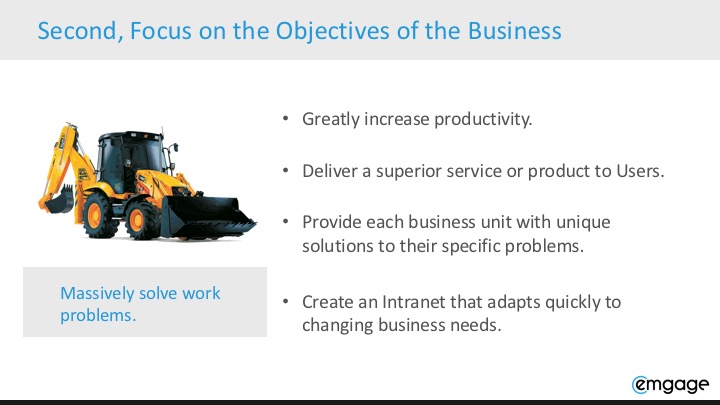No one would replace their beat up old Prius with another old Prius if they could access the awesome efficiency of a brand new Tesla. It simply wouldn't make sense.
Yet too many organizations are looking to replace InfoPath with a tool that is exactly the same; a tool that requires hours of coding and IT support. Emgage, has developed the premiere InfoPath Replacement Turbo, a product that sits on top of SharePoint and allows Users to create complex business applications without writing a single line of code.
Watch as Harout from Emgage test drives Turbo in the webinar below.
3 Keys to creating Successful Enterprise Technology
When you are choosing any piece of enterprise technology for your company, there are 3 essential criteria that you should consider.- It should be as natural as possible.
- It should result in a significant decrease in the amount of work required.
- It should have a positive economic impact.
Step 1: As Natural as Possible
Successful enterprise technology should be trending towards making work as natural as possible. This means hiding all the technical elements, putting them behind a wall so to speak, and creating a user interface that is natural and user friendly. One of the primary problems with InfoPath in its current state is that it requires a lot of coding, it typically requires an IT Department to create a form on the Business User's behalf. As a piece of enterprise technology it is not natural to the user, it is not intuitive, it doesn't allow the User to solve their own problems.So what?
As a result then, the process from problem identification (the User says: I need a form to solve this problem) to problem solution (User has a form to solve a problem) is far to convoluted and not natural. The form request has to be submitted to the IT department, where there is often a bottleneck. In the IT department, a person who is unfamiliar with the problem then attempts to create the solution. Again, this takes a long time.

Step 2: A Significant Decrease in Work
A lot of knowledge work is repetitive, so the goal of enterprise technology should be to organize and automate repetitive actions so that the user can work faster and concentrate his or her energy on things that truly matter. When you think of the analogy of a marathon runner who takes 33,000 steps on average to complete a marathon, you can see that the technology, in this case the running shoe, needs to be as light as possible so the runners legs carry very little repetitive weight."If your enterprise technology is too heavy, to work intensive (re:InfoPath), then the knowledge worker will get worn out not only by their work but also by the technology that was designed to assist them, not hinder them."Again, the goal of Turbo from Emgage is to carry the burden for the knowledge worker, providing them with actual solutions that reduce the load of repetitive actions.

Step 3: A Positive Economic Impact
Look at the example of the TESLA and ask: "Why has it been so successful?" Clearly there are several reasons, but one reason that stands out (clearly) is that it has a positive economic impact on a day to day basis for the user. Simply put, it is fully electric and so you do not have to fill up with gas.When you are looking for an InfoPath Replacement, one of the questions you also need to ask therefore is, "what product will have a significant daily, positive economic impact on our bottom line?"In particular with knowledge work and enterprise technology, you must ask, "what kind of technology will reduce the amount of human resource invested in providing a solution?" The fuel that knowledge work typically runs on is "human resource hours," so your goal in looking for the best InfoPath Replacement should be to significantly reduce human resource hours
Summary - Successful Enterprise Technology
The requirements for finding an InfoPath replacement clearly mirror the requirements for acquiring any piece of enterprise software. It should result in easier, more natural work that improves your bottom line.

 Technology that works is bought to you by Emgage Inc, the employee engagement specialists and Industry Leaders whose products
Technology that works is bought to you by Emgage Inc, the employee engagement specialists and Industry Leaders whose products  And this is our mission, to drastically improve how organizations create and use collaboration software. Our commitment to this purpose is expressed in our Business Software Bill of Rights as a promise to each and every one of our customer.
And this is our mission, to drastically improve how organizations create and use collaboration software. Our commitment to this purpose is expressed in our Business Software Bill of Rights as a promise to each and every one of our customer.


